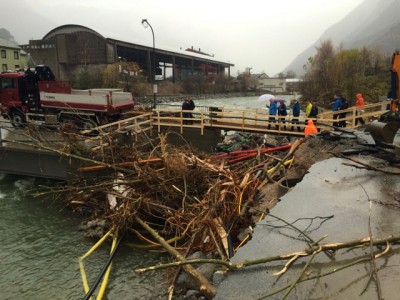A new climate report for Norway, updated by 37 researchers and meteorologists nationwide, confirms that torrential rain and flooding is already becoming normal as temperatures rise. Today’s so-called “extreme” weather won’t be so extreme, and buildings need to be secured against floods and rot.

“The main challenge for most Norwegians will be more heavy rains, larger and more floods sparked by rain and shorter periods with snow,” Hege Hisdal, a hydrologist for the Norwegian waterways and energy directorate (NVE), said when presenting the report to state officials.
The climate and ecological systems are changing quickly in Norway, according the report that updates one presented in 2009 that predicted more storms, shorter winters and long, wet springs, summers and falls. The only major change was a prediction for more rain and flooding east of the mountains of southern Norway and less on the west coast, which traditionally has had the most rain.
Norwegian agriculture and the fishing industry face major challenges. Warmer waters mean that fish stocks are already moving and changing, with more mackerel up north, for example. Farmers can expect longer growing seasons than they’ve traditionally had in Norway, but will probably also have to deal with drenched fields, drowned and rotting crops and less sunshine.
Entire beaches may disappear and rising seas will also threaten cities like Stavanger, Kristiansand and Bergen, where its historic wharf area called Bryggen already is frequently subject to high water. Waterfront developments need to be aware that the sea level may rise as much as half-a-meter by the end of this century unless there’s a drastic reduction in carbon emissions worldwide.

“We have to prepare ourselves,” said Tine Sundtoft, Norway’s environmental minister from the Conservative Party, noting that last week’s extreme weather system dubbed Petra “is a reminder of what we can expect.” She’s preparing to attend this year’s UN climate summit in Paris in December, where the pressure is strong to strike new deals to cut emissions.
The climate will continue to change regardless, she said, and government authorities, industry, business and private individuals all must “take responsibility” for adapting. Norway’s oil and mining industries remain the biggest culprits, though, and there’s little momentum to radically curtail them despite the low oil prices and financial troubles that are forcing cuts in operations.
Oil and Energy Minister Tord Lien claimed at a press conference this week that preventive measures are needed to help fend off damage from floods and rising seas. Environmentalists quickly urged more than preventive measures and adaptability, arguing that the causes of the climate change should be tackled hardest.
The report, prepared for Sundtoft’s ministry, covers atmospheric changes, hydrology, permafrost, the potential for landslides and changes in the seas, and builds on the UN’s last climate report. Norway’s version was prepared by researchers at the state ocean research institute (Havsforskningsinstituttet), the meteorological institute, the Nansen Center, NVE, Uni Research, the University of Bergen and the state mapping agency Kartverket.
Norway’s so-called oil fund, which saves and invests oil revenues for future generations, caught blame, meanwhile, for investing in many global companies that have been accused in another new report by London-based InfluenceMap of actively trying to resist measures to stop climate change. They include Reliance Industries, Procter & Gamble, Duke Energy and Phillips 66, although most deny the charges.
Newspaper Dagsavisen reported that Norway’s oil fund, one of the largest sovereign wealth funds in the world, has invested in 31 of the 33 companies on InfluenceMap’s list that got the worst climate scores. Arild Hermstad, leader of the environmental group Framtiden i våre hender (The future in our hands) urged the oil fund to pull out of such companies and reinvest the funds in others that scored well, including Unilever and Cisco.
newsinenglish.no/Nina Berglund

